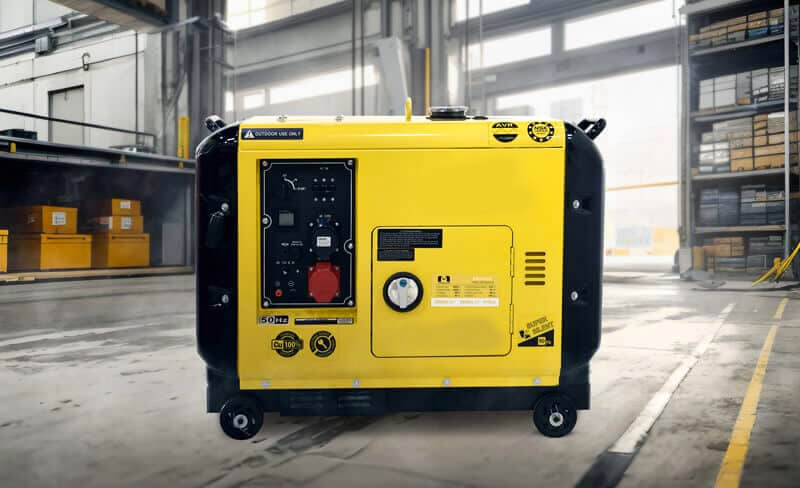24Apr 2024
table of contents

Diesel generators in normal operation are reliable emergency power sources that can relentlessly respond to sudden power outages anywhere.
However, while these generators are extremely durable and reliable, one particular problem they may encounter is disturbing blue smoke coming from the exhaust pipe. This unique blue smoke, unlike the usual clear exhaust or slight gray tint, is an immediate warning sign of a potential problem.
In this article, we’ll take a closer look at the causes behind blue smoke emissions, as well as important tips to fix them. Whether you're an experienced generator technician or an anxious operator noticing this problem for the first time, read on to learn the nitty-gritty of this generator phenomenon.
Obvious blue smoke from diesel generator indicates that generator is not only burning diesel but also burning engine oil, resulting in the production of dense blue or blue-gray exhaust gas.
Black smoke symbolizes inefficient combustion and indicates unburned diesel being expelled through the exhaust because there is too much fuel and too little air in the air-fuel mixture. White smoke, on the other hand, usually indicates unburned diesel fuel and can be caused by an engine misfire, a cold engine operating temperature, or other mechanical issues that cause incomplete combustion.
In contrast, if blue smoke is not resolved in time, it may lead to bigger problems. Let us understand the main reasons why diesel engines emit blue smoke.
Worn piston rings: Piston rings play a vital role in forming tight seal and preventing oil from seeping into combustion chamber. These rings can become worn, causing damage to the seal. If the seal is damaged, oil can leak out into the combustible mixture and release blue smoke as it burns.
Worn valve guides or seals: Valve guides play an essential role in preventing oil from trickling into combustion chamber, and facilitating functioning of intake and exhaust valves, which in turn permits air flow into engine while expelling exhaust gases. Nonetheless, deteriorated rails or seals may not successfully constrain oil, allowing it to infiltrate the cylinder chamber. Once inside, oil can combust, leading to emission of blue smoke.
Damaged piston or cylinder walls: Pistons and cylinders can also suffer from severe wear and tear from long-term use or poor maintenance, causing oil to enter the combustion chamber and subsequently burn into blue smoke.
High oil content: Overfilling engine oil, which leads to excessively high oil levels, can result in increased exhaust gas pressure within crankcase. This scenario effectively replicates the effects of a breather malfunction. Consequently, a significant amount of oil can intrude combustion chamber, culminating in the substantial emission of blue smoke.
Dirty air filter: An air filter that is unclean or blocked hinders engine from acquiring sufficient air required for combustion process. This limited air supply triggers incomplete combustion, and it also instigates siphoning of oil from crankcase into cylinder, leading to needless oil burning.
Fuel Injector problems: When it comes to fuel injector issues involved with diesel generators, leakages or malfunctions can allow unignited fuel to seep into engine oil. The resulting concoction of fuel and oil not only augments the overall oil amount, but also enhances its propensity to venture into combustion chamber. These factors together can instigate the emission of blue smoke.
Piston ring alignment: When piston rings in diesel engine become aligned, where gaps of piston rings in a single cylinder or all cylinders point in the same direction. Regardless of whether there's any wear on the cylinder liner and piston rings, in this scenario, overlapping of piston ring gaps forms a channel for oil to seep into combustion chamber, have to cause blue smoke emission.
Air compressor failure: Certain diesel generator models come fitted with air compressor, which typically uses diesel engine oil for lubricating and cooling its internal elements. In a situation where the air compressor's piston ring is worn out or the cylinder is under strain, a significant amount of compressed air could revert unpredictably to crankcase, leading to a decrease in exhaust capacity. This results in an excess of engine oil production during the intake phase. With the aid of cylinder's negative pressure, this surplus oil gets drawn into the combustion chamber to partake in combustion. This sequence of events results in the emission of blue smoke from exhaust.
Turbocharger failure: In a supercharged diesel generator, when the floating bearing on the compressor side of the supercharger is damaged, a large amount of oil may enter the diesel engine intake pipe through the compressor and then into the combustion chamber, producing blue smoke at startup. .
The above different reasons may be the key to solving the problem of blue smoke from diesel generators.
Solutions to diesel generator blue smoke problems fall into two broad categories: addressing worn or damaged engine parts and correcting other potential causes. Regular maintenance checks and promptly replacing or repairing worn components such as piston rings, valve guides, seals, pistons, cylinders, injectors, air compressors, and turbochargers. Moreover, maintaining the correct oil levels, ensuring that the air filter is clean, aligning piston rings properly, and quickly addressing malfunctions also play vital roles in diesel generator.
The most important preventive measure is to perform regular and comprehensive maintenance inspections as recommended by the manufacturer. Using high-quality motor oil and clean fuel, running generator fully under load to lubricate its components, and being proactive in addressing any emerging issues can prevent the problems that lead to blue smoke emissions from occurring. These steps will ensure your diesel generator's robust and efficient performance, maintaining its reliability without worrying about harmful exhaust emissions.

In summary, blue smoke from diesel generator indicates that oil is seeping into the combustion chamber and burning with the diesel. This unexpected problem is often caused by a variety of issues, including damaged engine parts, excess oil, dirty air filters, faulty injectors, misaligned piston rings, and faulty air compressor or turbocharger.
Ignoring these signs and delaying fixing such problems can seriously affect not only the efficiency of your diesel generator, but also its service life. Regular inspections, preventive measures and routine maintenance play an important role in keeping your diesel generator in good operating condition.
inquiry form here
BISON BLOG, All the latest news and views from Bison Machinery.